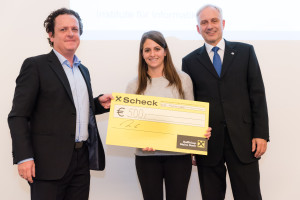 … ist der Titel der 3. Platz des Roland-Mittermeir-Preis und wurde vom Förderverein Technische Fakultät mit EUR 500,– ausgezeichnet. Dem Autor und Preisträger, Frau Dipl.-Ing.in Jennifer Simonjan, wurde der Preis im Rahmen des Festakts 30 Jahre Informatik an der Alpen-Adria-Universität Klagenfurt übergeben und die Arbeit wird hier kurz vorgestellt:
… ist der Titel der 3. Platz des Roland-Mittermeir-Preis und wurde vom Förderverein Technische Fakultät mit EUR 500,– ausgezeichnet. Dem Autor und Preisträger, Frau Dipl.-Ing.in Jennifer Simonjan, wurde der Preis im Rahmen des Festakts 30 Jahre Informatik an der Alpen-Adria-Universität Klagenfurt übergeben und die Arbeit wird hier kurz vorgestellt:
Ubiquitous computing has been in the focus of research for several years. In the near future, many of our everyday devices will be interconnected to optimally support us in our daily routines. The term Internet of Things deals with this inter-connectivity of everyday smart devices such as smartphones, tablets or even ordinary electronic devices at home. Increasing the comfort of humans is one of the main objectives of such Internet of Things applications, which can for instance be in the field of smart homes or offices. Such applications typically consist of several intelligent devices, which try to achieve certain goals cooperatively. These devices should coordinate themselves without the need for human interaction and without any central control guiding them. Thus, Internet of Things applications typically need to deal with decentralization and self-organization.
The focus of this thesis lies on decentralized and self-organized networks, paying particular attention to Internet of Things applications. This topic was first discussed theoretically, explaining decentralization and some ideas and concepts of self-organization. As practical use case, a smart lighting application was developed to enable an implementation and evaluation of the theoretical concepts. This application consists of a distributed wireless network of intelligent light bulbs which are able to take autonomous decisions. First, a formal description was developed to enable a mathematical definition of the problem structure. Various self- organizing algorithms, which enable the lights to make autonomous decisions to achieve certain common goals, were designed afterwards. To enable a simulation and evaluation of the formal designed algorithms, a simulator was implemented and used for evaluations.
Further, a demonstrator consisting of six smart light bulbs was built in the lab environment. This demonstrator enables a presentation of the algorithms, showing the behaviour of real light bulbs while performing self-organization and communication in a distributed manner. Finally, the demonstrator was evaluated to get a comparison between the real applications and the results of the simulation.
